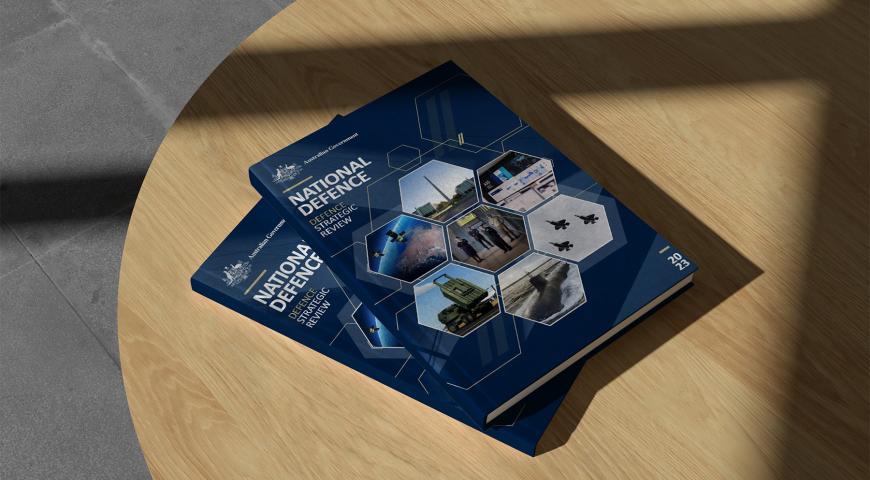In the heavily interconnected global commons, Australia is inseparable from the various strategic competition pathways outlined in the 2020 Defence Strategic Update (DSU) and 2023 Defence Strategic Review (DSR). Understanding the complex problem set of global and regional strategic competition, and in particular the motives, objectives and strategies of the actors, requires a new approach by Defence. The DSR recommends such an approach for defence strategy and strategic planning. It is called ‘net assessment’.
Net assessment is the method by which Defence can better understand the complex circumstances Australia faces in developing the defence strategy for long-term capability generation, and military strategy for applying military power, along with other instruments of national power to achieve the government’s near-term objectives. This practice has been established for nearly 50 years in the US Department of Defense and was adopted by the UK Ministry of Defence in late 2020. A net assessment practice will strengthen senior Defence leader decision-making and support national strategy development and implementation. This article will summarise the strategic environment faced by Australia, examine net assessment as a means for understanding the environment, and propose an option for Defence to implement the DSR recommendation.
Australia’s strategic context
The 2020 DSUstated Australia is at the ‘centre of a dynamic strategic environment’.[1] Australia is entwined in a global strategic competition, primarily between the US (the superpower remaining at the end of the Cold War) and China (the emerging superpower) but also involving other powerful countries including Japan, India, Russia and the UK. Similarly entangled are other countries and country groupings with whom Australia has diplomatic, trade and military relations, including the Association of Southeast Asian Nations (ASEAN), the Pacific Islands Forum (PIF) and the European Union (EU). Australia is inseparable from the various possible strategic competition pathways existing on our deeply interconnected planet.
The DSU notes Australian interests are being directly or indirectly targeted through coercion, competition and the grey zone.[2] This has led to a reduction in strategic warning time[3] which the DSU says is ‘no longer an appropriate basis for defence planning’ and the government cannot ‘assume Australia will have time to gradually adjust military capability and preparedness in response to emerging challenges’.[4] The DSR states the loss in strategic warning time ‘necessitates an urgent call to action, including higher levels of military preparedness and accelerated capability development’.[5] Our competitors—primarily China and Russia—employ hybrid warfare tactics[6] and use political warfare[7] or unrestricted warfare[8] to confront a more militarily powerful West. The British Integrated Operating Concept outlines how their military will tackle the future operating environment, emphasising ‘the importance of integration with allies, of the levers of statecraft, and across the five operational domains[9]—multi-domain integration’.[10] Understanding the complex problem set of global and regional strategic competition, and in particular the motives, objectives and strategies of all relevant parties, requires a novel approach by Defence.
The British Government has attempted to address the same issue in recent years. Elefteriu observes in a policy paper for the British Government, ‘The West in general … has had a consistent record of strategic underperformance in recent decades, which points to chronic deficiencies in assessing accurately the strategic environment and the behaviour of rivals. This needs to be addressed as a matter of priority in view of the sharpening geopolitical competition.’[11] The British policy paper offered a framework to provide a ‘deeper understanding of both our own and our adversaries’ power as the basis for strategy’.[12] Defence should heed the need to better understand the strategic environment, as well as Australian national, defence and military strategies[13], and our potential adversaries.
Dibb and Brabin-Smith argue the required approach ‘goes beyond the traditional collection and analysis of data that make for ‘intelligence appraisals’.[14] They call for a net assessment to be an ‘obligatory part of the policy advising process in the Australian Defence organisation’, one requiring ‘a deep understanding not only of Australia’s potential adversaries but also of the strengths and weaknesses of our own war-fighting capabilities’.[15] Net assessment is the method by which Defence can better understand the complex circumstances it faces to develop defence strategy and military strategy. The former is required for long-term capability generation and the latter is needed to apply military power alongside the other instruments of national power[16] to achieve the government’s near-term objectives.
The British Government has adopted an approach like the US as a ‘tried and tested way to distil coherence from today’s chaotic world’.[17] In December 2020, the UK Defence Secretary announced the establishment of a ‘net assessment and challenge function’ in the Ministry of Defence (MOD).[18] The new MOD unit—called the Secretary of State’s Office for Net Assessment and Challenge (SONAC)—works to ‘ensure strategies are tested by independent and diverse voices before they are implemented in the face of future strategic challenges.’[19] Defence in Australia is in a similar position to that of the UK Ministry of Defence before adopting net assessment, with multiple groups often independently addressing components of the complex problem set.[20] A net assessment function is the DSR recommended option for Defence to study complex strategic problems. Such a function will determine asymmetries between Australia (an actor with less relative power) and our stronger possible adversaries which can be targeted or protected.
Defining net assessment
The US Department of Defense defines net assessment as ‘the comparative analysis of military, technological, political, economic, and other factors governing the relative military capability of nations’, and its purpose as being ‘to identify problems and opportunities that deserve the attention of senior defense officials’.[21] A net assessment is a framework that uses a multi-disciplinary methodology to ‘capture the dynamics of national or coalition military strengths and weaknesses for comparison with the capabilities of competitors and adversaries’.[22] A net assessment does not produce solutions to problems but offers insights to senior officials and forms the basis of strategic decision-making.[23] A net assessment approach to complex strategic problems should: be a ‘living methodology’, embrace uncertainty,[24] look for strategic asymmetries between the various actors, and identify opportunities and challenges in support of policymakers and strategists.[25] A net assessment should be the basis upon which to formulate and assess defence and military strategies.
Adamsky notes net assessments rely on the modelling of a ‘dynamic and multidimensional competition between strategic antagonists’.[26] A net assessment could frame the current and future global and regional competitions in which Australia is an actor. The integrated diagnostics approach incorporates the ‘available social-ideational-cultural-organizational characteristics’ of the competing actors and aims to ascertain the ‘intended and unintended first- and second-order consequences of the interactions over time’.[27] The multi-disciplinary analyses forming the net assessment framework are ‘comparative, diagnostic and forward-looking’ and enable the evaluation of ‘military balances and strategic competition’.[28] For example, a net assessment would allow Defence to look at the interactions of Australia and its partners (whether under ANZUS, AUKUS, FVEYS, QUAD or other arrangements) and China and its partners, either alone or acting in concert. The results providing decision-makers the insights required to agree on the theory of success, objectives and courses of action for defence and military strategies.
Net assessment can take various forms depending on the problem being addressed. Dibb and Brabin-Smith note Andrew Marshall[29] specified four categories of net assessment:
- foreseeing potential conflicts
- comparing strengths and predicting outcomes in given contingencies
- monitoring current developments and being alerted to developing problems, and
- warning of imminent military danger.[30]
These categories are all applicable to the needs of Defence, especially when formulating forward-looking, capability-driven defence strategy and developing ways to apply military power as part of a contemporary military strategy supporting a national strategy. The next section will present the benefits net assessment could bring to Defence.
Potential benefits. Defence could use net assessment to improve three areas of strategic decision-making. The first is better understanding the current strategic environment to inform military strategy formulation for achieving the shape and deter strategic objectives set by the government in the DSU[31] and reaffirmed in the DSR[32]. The second is to improve future war analysis to inform long-term capability generation. The third is to enable enhanced strategic decision-making across the Australian national security apparatus, giving Defence a greater voice. These are explored below.
A key outcome of net assessment is identification of critical asymmetries which favour Australia, or which Australian strategy could exploit. In the Cold War, the US ‘sought to illuminate both trends and asymmetries in the behavior of the US and its allies in contrast to the behavior of the Soviet Union and its allies’ with the object of outlasting the Soviets in the long-term and encouraging the Soviets to ‘devote resources to activities that were less threatening or even favorable to the US’.[33] Australia, both unilaterally and in coordination with partners, could identify asymmetries with China, Russia and other future competitors to be exploited, even from a position of apparent relative weakness. Net assessment can highlight ‘cultural-organizational factors that shape strategic behavior, especially those inclinations which result in suboptimal, self-defeating and counterproductive actions’.[34] These asymmetries and counterproductive actions could present ‘means’ and ‘ways’ for achieving Australian military strategy ‘ends’, both in terms of unilateral and collective actions, as well as synchronised with the other instruments of national power.
To achieve this, Australia needs a holistic approach to viewing strategic competition in the Indo-Pacific region—the ADF’s primary operating environment. In the region, Australia ranks sixth in the 2023 Lowy Institute Asia Power Index[35] behind the US, China, Japan, India and Russia.[36] Compared to China, Australia scores poorly on economic capability and relations, military capability, resilience, diplomatic influence and future resources, but scores well above China for defence networks.[37] On face value, the relative power imbalance between Australia and China may seem like a hopeless position from which Australia cannot compete; however, history shows the way the instruments of national power are employed can enable weaker powers to compete with, and sometimes defeat, stronger powers.[38] Net assessment offers Defence a means to look beyond the apparent insurmountable power imbalance—Lowy’s index states Australia ‘exerts more influence in the region than expected given its available resources’[39]—to determine where exploitable asymmetries exist. For example, the economic coercive actions with which China is targeting Australia may present opportunities other statecraft tools could exploit, including combined military activities and enhanced defence engagement.
Further, Defence could benefit from the practice of net assessment in terms of longer-term capability generation. Net assessments can enable examination of ‘the evolution of the character of war’ and assess the expected performance of the current ADF force-in-being and the emerging capabilities of the ‘objective force’ ‘relative to those of our adversaries’.[40] This is achieved through capturing ‘the pace and intensity of long-term competition’[41] and establishing trends which can assess the prospects of the ADF’s future force capabilities and national potential in comparison with those of other countries or groups of countries’[42]—such as China and Russia, or other potential future adversaries. Net assessment can generate alternate futures in which the future ADF can be designed and evaluated to exploit identified asymmetries. These futures provide the circumstances in which defence strategy is formulated, including prioritising constrained national resources, to achieve the government’s long-term national security objectives.
Like the US Office of Net Assessment (ONA), a Defence net assessment function could benefit other areas of government. The practice can provide ‘objective and independent analyses of national policy, doctrine, strategy, goals, objectives, and capabilities’[43] across Australia’s national security entities. This analysis can inform National Security Committee of Cabinet (NSC) decision-making on a wide range of strategic competition issues, including decisions for the best ways to spend the foreign aid budget, intelligence collection priorities or the impact of non-traditional threats on strategic competition. The provision of such analysis will ensure Defence is a vital contributor to holistic national strategy.
Net assessment limitations. Elefteriu notes net assessment ‘is not, by itself, an assured “golden ticket” out of complex systemic problems’.[44] Net assessment has limits and there are arguments against such a practice. Firstly, it can be argued the US, with its established net assessment framework and as a close ally, or the UK, could be relied upon to provide Australia the relevant analysis to enable Australian strategic decision-making. Secondly, net assessments are resource intensive, rely on a wide range of subject matter experts, and the process is too difficult due to the complex problem set. Finally, Defence already does ‘net assessment-like’ activities and change is not justified. These arguments are addressed below.
While an Australian net assessment should include ally and partner input, Australia cannot rely on a US (or other) net assessment to make sovereign strategic decisions. Our partners will be the source of intelligence, will provide alternate views and have expertise not found in Australia. However, their judgments, and the lens through which they look at the complex strategic problems, are shaped by their own interests. While we share interests, Australia has divergent positions on national security matters. Further, the assessment of adversary actions and reactions will be different in response to Australia than the US. Australia should harness the US net assessments experience and involve our partners (to the greatest extent possible on an extremely sensitive assessment), but Australia should have a sovereign net assessment function to protect and advance its national interests.
Net assessments are resource intensive. Shulsky notes the process places ‘a major burden on the intelligence community’ and seeks information to questions the Defence Intelligence Group would not normally address.[45] When multiple actors are considered on both sides—such as the QUAD compared to a China-Russia strategic alignment—a wide and deep range of subject matter expertise is required. Analysts must be ‘immersed in available data on past and current actions’ by the competitor/adversary and ‘exercise their imagination in reconstructing perceptions of strategy, doctrine, weapons, etc, supporting them’[46], as well as China’s and Russia’s knowledge of QUAD members.[47] The net assessment approach underscores the need for adversary expertise; however, no one discipline trains people in this manner.[48] While such expertise is limited within Defence, it exists more broadly across the National Intelligence Community, as well as in universities and amongst our allies. Such specialists would not need to be permanent members of a Defence net assessment function but would need to be security vetted and available to contribute on an as-required basis. This is not insurmountable but would take several years to fully establish.
A net assessment function will be of benefit to Defence in the formulation of military and defence strategies, as well as to the wider national security community. Net assessments have their limitations and require considerable effort to produce, but the benefits outweigh the costs. The means by introducing a net assessment approach into Defence will be proposed.
Net Assessment for Defence in Australia
A Net Assessment Branch (NAB) is a feasible option for Defence. This model proposes an independent unit dedicated to net assessment, responsible to the Secretary of the Department of Defence and Chief of the Defence Force (CDF).[49] The unit—recommended branch-sized—should be an independent entity similar to the Inspector-General of the ADF and outside of the broader Defence chain of command. The US ONA has approximately 12 permanent staff[50]; thus the NAB should have at most 10 permanent staff. Aside from the Band-one/1-Star, the mixed civilian-military staff should be on long-term secondment[51] from the various Defence divisions, including the Defence Intelligence Organisation, Strategic Policy Division, Contestability Division, Military Strategic Plans Division, Force Design Division, the Australian Defence College’s Centre for Defence Research and the Defence Science & Technology Group. The permanent staff would be supported on an as-required basis by other specialist analysts and strategists from across Defence, the interagency and academia. The ‘independent’ net assessment would be presented to Secretary-CDF and the Minister on a quarterly or semi-annual basis, or as required if focused on emergent strategic issues. The net assessment would enable government direction into military and defence strategies, as well as support the Secretary and CDF to provide their strategy guidance.
Advantages. The advantages of this model are:
- An independent entity would be free of influence from the wider Defence enterprise, allowing it to ‘inform high-level decision-making in an independent fashion, including on the shortcomings of our own defence planning and assumptions, and on those of our allies’.[52]
- A dedicated net assessment entity would be free of distractions and ‘crisis tasks’ normally associated with high-performing units in a strategic headquarters.
- The central team would contain specialists from their fields but would also have access to further analysis and experts from their parent units.
- A small team would be able to maintain the required level of secrecy.
- The team could establish a working relationship with their US and UK counterparts and be the coordinating function for partner input and briefings.
Disadvantages. The disadvantages of such a model are:
- A team of no more than 10 would not have representation from all divisions who may think they have equity in the analysis and product. Lack of ownership may result in poor support unless clear direction is provided by the Secretary and CDF.
- Security clearances for the required specialists in academia may be difficult to achieve, although this could be managed by compartmentalising their input.
Conclusion
Australia is a participant in a global strategic competition the level of which has not been seen since the Cold War. The strategic environment is extremely complex, with many actors—both state and non-state—working independently and/or collectively to pursue their national interests or organisational objectives. Understanding (as best as possible) the environment, the relationships and interactions is important for Australia to be able to develop and implement military strategy for applying military power to achieve national objectives and defence strategy to generate future military capability.
Defence does not have a coherent means of assessing the environment and the interactions of strategic competitors. Within the enterprise there are various entities performing complementary roles, but not in a holistic or coordinated manner. The DSR recommends Defence follow the lead of our US and UK allies by adopting a net assessment practice which ‘supports development of so-called competitive strategies’ that seek ways to ensure Australia’s strengths are ‘mobilized to maximum advantage while the weaknesses of the adversary are fully exploited’.[53] The ‘analytical worth’ of net assessments in ‘guiding strategic action is undeniable’.[54] Defence should establish an independent NAB, answerable to the Secretary and CDF and providing them and the government with insights to support strategic decision-making for matters of military and defence strategy. Once the delivery mechanism of Net Assessment is decided, the next step will be determining the overall theme and focus area(s) for the net assessment. This will determine which actors to assess, and the time horizon(s) being considered.
1 Department of Defence, 2020 Defence Strategic Update (Canberra, ACT: Department of Defence, Australian Government, 2020), 5.
2 ‘ ‘‘Grey zone” is one of a range of terms used to describe activities designed to coerce countries in ways that seek to avoid military conflict. Examples include using para-military forces, militarisation of disputed features, exploiting influence, interference operations and the coercive use of trade and economic levers. These tactics are not new. But they are now being used in our immediate region against shared interests in security and stability. They are facilitated by technological developments including cyber warfare.’ Department of Defence, 2020 Defence Strategic Update, 12 and 14.
3 ‘Strategic warning time for conventional conflict is the time a country estimates an adversary would need to launch a major attack against it, once the adversary’s intent to do so has been established. This period is determined by indications of preparation and mobilisation of resources and capabilities.’ (Defence 2020:15)
4 Department of Defence, 2020 Defence Strategic Update, 14.
5 Australian Government, Defence Strategic Review (Canberra, ACT: Australian Government, 2023), 25.
6 Frank Hoffman defines hybrid warfare as wars that‘incorporate a range of different modes of warfare, including conventional capabilities, irregular tactics and formations, terrorist acts including indiscriminate violence and coercion, and criminal disorder.’ Frank Hoffman, Conflict in the 21st Century: The Rise of Hybrid Wars (Arlington, VA: Potomac Institute for Policy Studies, 2007), 29, accessed 28 August 2021.
7 George Kennan wrote in 1948, ‘Political warfare is the logical application of Clausewitz’s doctrine in time of peace. In broadest definition, political warfare is the employment of all the means at a nation’s command, short of war, to achieve its national objectives. Such operations are both overt and covert. They range from such overt actions as political alliances, economic measures (as ERP), and ‘white’ propaganda to such covert operations as clandestine support of ‘friendly’ foreign elements, ‘black’ psychological warfare and even encouragement of underground resistance in hostile states.’ George F Kennan, The Inauguration of Organisation Political Warfare [Redacted version], History and Public Policy Program Digital Archive, 30 April 1948, 1, accessed 18 March 2021.
8 Unrestricted Warfare is a book published in China in 1999 written by two People’s Liberation Army officers, Colonel Qiao Liang and Colonel Wang Xiangsui that explores strategies that militarily and politically disadvantaged nations might take to successfully attack a geopolitical superpower like the US.
9 The five domains are the land, maritime, air, space and cyber/electro-magnetic operating environments.
10 UK Ministry of Defence, Integrated Operating Concept (London, UK: Ministry of Defence, 2021), 3.
The US military have similar concepts in the form of the Joint Concept for Integrated Campaigning and The U.S. Army in Multi-Domain Operations 2028.
Palazzo suggests, ‘What we are witnessing is the compression of the dimensions of war in which domains will largely be irrelevant, the blending of tactics into strategy, and a reduction in the constraints traditionally imposed by distance and time in the conduct of operations.’ He expands by saying, ‘as the strategic and the tactical blend into each other the principles of the strategic must dominate’. Albert Palazzo, Planning to Not Lose: The Australian Army’s New Philosophy of War, Australian Army Occasional Paper No. 3 (Canberra, ACT: Australian Army Research Centre, 2021), 22 and 26.
11 Gabriel Elefteriu, A Question of Power: Towards Better UK Strategy Through Net Assessment (London, UK: Policy Exchange, London 2018), 11, accessed 18 October 2021.
12 Elefteriu, A Question of Power, 5.
13 Grand or national strategy is an intellectual framework from which a theory can be derived for creating and orchestrating the instruments of power (a state’s means) in support of a state’s national interests and long-term policy ends.
Defence strategy is an enterprise-wide theory for creating military power to be used, or threatened to be used, in support of achieving a government’s long-term policy ends—principally defending the state and its national interests—in an assessed future security environment.
Military strategy is a theory for applying military power—the use or threatened use—to achieve a government’s ends, where the strategic military objectives are a subset of the national strategy goals.
Michael Scott, ‘Many Strategists but Little Strategy: Addressing a Deficiency in Australia’, Australian Journal of Defence and Strategic Studies 4, no. 1 (June 2022): 39–64, https://defence.gov.au/ADC/Publications/AJDSS/Volume4-number1/many-strategist-little-strategy.asp.
14 Paul Dibb and Richard Brabin-Smith, Deterrence through denial: A strategy for an era of reduced warning time (Barton, ACT: Australian Strategic Policy Institute, 2021), 8, accessed 18 October 2021.
15 Dibb and Brabin-Smith, Deterrence through denial: A strategy for an era of reduced warning time, 8.
16 The instruments (or elements) of national power, a common term used to express a state’s ‘means’, is commonly described by the acronym DIME. DIME is what gives a nation its ‘power’, defined in ADF-C-0 Foundations of Australian Military Doctrine as the ‘sum of all resources available to a nation to use in the pursuit of national objectives’ (2021:20). The US National War College Security Strategy Primer lists the instruments of national power as Diplomatic (representation, negotiation and implementation), Informational (perceive, inform and manipulate), Military (force, threat of force and force enabling) and Economic (assistance, trade and finance) (2020:22).
17 Elefteriu, A Question of Power, 11.
18 Rt Hon Ben Wallace MP (UK Defence Secretary), Defence Secretary's speech at the RUSI Conference covering the Integrated Review, the spending review settlement and other issues for defence [transcript], UK Ministry of Defence, 11 December 2020), 3, accessed 18 October 2021.
The Secretary argued ‘threat’ should drive the British mission rather than ‘infrastructure, HR and savings measures’ which were important but of secondary concern to the ‘evolving threats and increasingly emboldened adversaries’. Wallace, Defence Secretary’s speech, 2.
19 UK Ministry of Defence, Announcement of new Director appointed to the Secretary of State’s Office for Net Assessment and Challenge (SONAC), Press Release, 6 May 2022, https://www.gov.uk/government/news/announcement-of-new-director-appointed-to-the-secretary-of-states-office-for-net-assessment-and-challenge-sonac.
20 These groups and divisions include Defence Intelligence Group, Strategy, Policy & Industry Group, Force Design Division, Force Integration Division, Military Strategic Plans Division, the Australian Defence College and the Defence Science & Technology Group.
21 US Department of Defense (DOD), DoD Directive 5111.11 Director of Net Assessment (Washington DC: Office of the Chief Management Officer of the Department of Defense, 2020), 9, accessed 18 October 2020.
22 Thomas G Mahnken (ed), Net Assessment and Military Strategy: Retrospective and Prospective Essays (Amherst, NY: Cambria Press, 2020), 11.
Bracken classifies net assessment as a ‘practice’ for tackling problems, as opposed to ‘an art (like military judgment)’ or ‘a science (like chemistry)’. Paul Bracken P, ‘Net Assessment: A Practical Guide’, Parameters 36 no. 1 (Spring 2006): 90-100, 91, accessed 14 May 2021.
23 Mahnken, Net Assessment and Military Strategy, 11.
24 Andrew F Krepinevich, ‘Measures of Power: On the Lasting Value of Net Assessment’, Foreign Affairs, Council on Foreign Relations Inc, 19 April 2019, 3, accessed 18 October 2021.
25 Mahnken, Net Assessment and Military Strategy, 15.
26 Dmitry (Dima) Adamsky, ‘The art of net assessment and uncovering foreign military innovations: Learning from Andrew W. Marshall’s legacy’, Journal of Strategic Studies 43, no. 5 (27 July 2020): 611-644, 612, accessed 18 October 2021.
27 Adamsky, The art of net assessment and uncovering foreign military innovations, 612.
28 Mahnken, Net Assessment and Military Strategy, 15.
29 ‘[Andrew] Marshall, along with experts from his legendary Pentagon Office of Net Assessment (ONA), which he headed between 1973 and 2015, have been most associated with the invention of the unique, and today widely referenced, analytical technique known as net assessment.’ Adamsky, The art of net assessment and uncovering foreign military innovations, 612.
30 Dibb and Brabin-Smith, Deterrence through denial: A strategy for an era of reduced warning time, 8.
31 Department of Defence, 2020 Defence Strategic Update, 4.
32 Australian Government, Defence Strategic Review, 50.
33 Mahnken, Net Assessment and Military Strategy, 2-3.
34 Adamsky, The art of net assessment and uncovering foreign military innovations, 641.
35 ‘The annual Asia Power Index—launched by the Lowy Institute in 2018—measures resources and influence to rank the relative power of states in Asia. The project maps out the existing distribution of power as it stands today, and tracks shifts in the balance of power over time. The Index ranks 26 countries and territories in terms of their capacity to shape their external environment—its scope reaching as far west as Pakistan, as far north as Russia, and as far into the Pacific as Australia, New Zealand and the United States.’ Lowy Institute, 2023.
36 Lowy Institute, Lowy Institute Asia Power Index: 2023 Edition, Map, accessed 30 April 2023.
37 Lowy Institute, Lowy Institute Asia Power Index: 2023 Edition, Compare, accessed 30 April 2023.
38 Examples include colonial Americans against the British empire in the late-18th Century, Israel against its Arab neighbours (especially in the decades following Israel’s founding in 1948), and the Vietnamese defending against the French, America and then China (although Vietnam has a longer history of conflict with China).
39 Lowy Institute, Lowy Institute Asia Power Index: 2023 Edition, The Power Gap, accessed 30 April 2023.
40 US Department of Defense (DOD), DoD Directive 5111.11 Director of Net Assessment, 4.
41 Mahnken, Net Assessment and Military Strategy, 20.
42 US Department of Defense (DOD), DoD Directive 5111.11 Director of Net Assessment, 21.
43 US Department of Defense (DOD), DoD Directive 5111.11 Director of Net Assessment, 4.
44 Elefteriu, A Question of Power, 11.
45 Mahnken, Net Assessment and Military Strategy, 179-180.
46 Mahnken, Net Assessment and Military Strategy, 180.
47 Mahnken, Net Assessment and Military Strategy, 190.
48 Mahnken, Net Assessment and Military Strategy, 192.
49 Alternatively, the NAB could report directly to the Minister for Defence if the Minister is the strategic leader who is seeking ‘independent’ analysis. This is the model of the US DOD and UK MOD.
50 Elefteriu, A Question of Power, 8.
51 Likely in their second year of a two or three year posting to their parent group or service.
52 Elefteriu, A Question of Power, 7.
53 Mahnken, Net Assessment and Military Strategy, 178.
54 Elefteriu, A Question of Power, 11.
Defence Mastery
Please let us know if you have discovered an issue with the content on this page.
Comments
Start the conversation by sharing your thoughts! Please login to comment. If you don't yet have an account registration is quick and easy.




